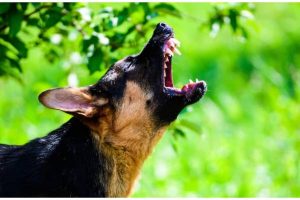Unveiling Canine Intuition: Can Dogs Sense Evil?
According to recent studies, there is a growing interest in understanding the sensory perception and cognitive abilities of dogs. One intriguing aspect that has captured the attention of researchers and pet owners alike is whether or not dogs can sense evil.

This notion suggests that dogs possess an innate ability to detect malevolence or harmful intentions in humans or other animals. While anecdotal evidence and personal experiences often support this belief, it is important to approach this topic with scientific rigor.
By examining canine instincts, behavioral cues, emotional bonds with humans, learned behavior, and empirical studies conducted on this subject matter, we can gain a better understanding of whether dogs are truly capable of sensing evil.
This article aims to explore the existing body of knowledge and provide an objective analysis of this fascinating phenomenon within the context of scientific inquiry.
Canine Instincts and Sensory Perception
The canine species possesses heightened sensory perception and instincts that allow them to detect subtle changes in their environment, potentially including the presence of malevolent intentions.

Canine intuition is often attributed to their acute sense of smell, which is far more developed than that of humans. Dogs possess a specialized olfactory system that enables them to detect odors at concentrations as low as parts per trillion. This exceptional ability has been harnessed by law enforcement agencies for tasks such as drug detection and search and rescue operations.
Furthermore, dogs have been known to exhibit supernatural abilities, such as sensing impending seizures or detecting certain types of cancer in humans. While these phenomena are not fully understood, they highlight the remarkable sensory perceptions possessed by canines.
Further research into canine instincts and sensory perception may shed light on their potential ability to sense malevolence in their environment.
Behavioral Cues and Body Language
Behavioral cues and body language can provide valuable insights into the emotional states and intentions of animals. Research has shown that humans are able to accurately interpret nonverbal cues in dogs about 80% of the time.

As for the ability of dogs to sense evil, there is no scientific evidence to support this claim. Dogs have evolved alongside humans for thousands of years and have developed a keen ability to read human emotions and intentions through their facial expressions, vocalizations, and body postures.
They can detect subtle changes in facial expressions such as raised eyebrows or narrowed eyes, which may indicate fear or aggression. However, it is important to note that interpreting these cues requires context and should not be solely relied upon to determine if someone or something is ‘evil.’
Dogs’ ability to sense danger or threat is based on their instinctual survival mechanisms rather than an innate understanding of good versus evil.
Emotional Bond with Humans
Emotional bonds between humans and canines have been widely studied, revealing a deep connection that transcends verbal communication. This emotional attachment is often described as an empathetic connection, where dogs are able to understand and respond to human emotions.
Research has shown that dogs possess the ability to detect and respond to human emotional cues, such as facial expressions and tone of voice. They are capable of reading subtle changes in our body language and can sense when we are feeling sad, happy, or distressed.
Additionally, dogs have been observed to exhibit behaviors that reflect their emotional bond with humans, such as seeking comfort during times of distress or displaying signs of happiness when reunited with their owners.
These findings highlight the unique nature of the relationship between humans and dogs, characterized by a strong emotional connection and mutual understanding.
Learned Behavior and Conditioning
This discussion will focus on two key points: training and socialization, and the reinforcement of protective instincts.
Training and socialization play crucial roles in shaping a dog’s behavior, ensuring that they can interact appropriately with humans and other animals.
Additionally, dogs’ protective instincts can be strengthened through reinforcement techniques, which can help them become effective guard dogs or protectors in certain situations.
Training and Socialization
Training and socialization play a crucial role in shaping a dog’s ability to perceive and respond to various stimuli, including potential threats or harmful situations. Canine fear responses can be influenced by early socialization experiences, where positive interactions with other dogs and humans can help build confidence and reduce anxiety. Conversely, negative experiences during this critical period can lead to fear-based behaviors later in life. Training methods that focus on positive reinforcement and reward-based techniques are effective in teaching dogs appropriate responses to different situations. By exposing dogs to different environments, people, animals, and objects at an early age, they develop the skills necessary to navigate the world with confidence and resilience. Additionally, ongoing training throughout a dog’s life helps reinforce desired behaviors and provides opportunities for continued socialization.
| Positive Impact of Training | Negative Impact of Lack of Training | |
|---|---|---|
| Behavior | Improved obedience | Aggression |
| Socialization | Enhanced interaction skills | Fearfulness |
| Safety | Decreased risk of accidents | Increased risk of conflicts |
| Bonding | Strengthened human-dog bond | Weakened relationship |
Reinforcement of Protective Instincts
Reinforcement of a dog’s protective instincts can have a significant impact on their behavior and responses towards potential threats or harmful situations. This is particularly true for dogs with protective breed characteristics, as they often possess natural guarding instincts that can be further developed through training and socialization.
First, consistent reinforcement of protective behaviors such as alertness, barking at strangers, and territoriality helps to strengthen a dog’s natural instinct to protect their territory and loved ones.
Second, positive reinforcement techniques like rewards and praise can be used to encourage desired behaviors while discouraging aggressive or overly reactive responses.
Third, exposing the dog to various stimuli in controlled environments can help them differentiate between genuine threats and harmless situations.
By reinforcing these protective instincts in a controlled and positive manner, dogs can become more confident in their ability to assess potentially dangerous situations and respond appropriately. This ultimately serves both the dog itself and those around them by providing a sense of security.
Scientific Explanations and Studies
Scientific research and studies have explored the possibility of dogs possessing an innate ability to sense malevolence or evil, evoking curiosity and fascination among researchers and dog enthusiasts alike.
One possible explanation for this phenomenon lies in evolutionary adaptations. Dogs, as descendants of wolves, have developed keen senses to survive in their natural environment. Canine olfactory abilities, specifically their highly developed sense of smell, allow them to detect various scents that humans cannot perceive.
This heightened sense could potentially enable them to pick up on subtle changes in human body odor or pheromones associated with negative emotions or intentions. While there is limited scientific evidence directly linking dogs’ ability to sense evil, anecdotal reports and ongoing research suggest that they may possess a unique sensitivity towards detecting malevolence in certain situations.
Further investigation is needed to fully understand the extent of dogs’ capabilities in this area.
See also:
Top 5 Reasons Why Dogs Are Better Than People
The most Impressive feats of Trained Dogs
Frequently Asked Questions
Are there any specific breeds of dogs that are more likely to sense evil?
Do specific dog breeds possess a heightened ability to sense evil? The role of instincts and the influence of training and socialization play significant roles in a dog’s ability to detect malicious intentions.
Can dogs sense evil in people they have never met before?
Dogs have a remarkable ability to sense emotions and detect changes in human behavior. While it is unclear if they can specifically sense evil, their intuition allows them to pick up on cues that may indicate negative intentions in people they have never met before.
Is it possible for dogs to sense evil intentions even if a person is acting friendly?
Dogs have been observed to exhibit behaviors that suggest they can detect hidden malevolence in individuals, even when they appear friendly. This suggests that dogs may possess a sixth sense for detecting evil intentions.
Can dogs sense evil spirits or supernatural entities?
Euphemistically speaking, it is unclear if dogs can detect paranormal activity. However, they possess the ability to sense danger or evil intentions in humans through their instinctual gut feelings, which may be of service to others.
Are there any signs or behaviors that dogs exhibit when they sense evil?
Dogs may exhibit certain body language cues when sensing potential danger or threat, such as raised hackles, growling, barking, or showing signs of aggression. They can also sense negative energy in animals or other non-human beings.
